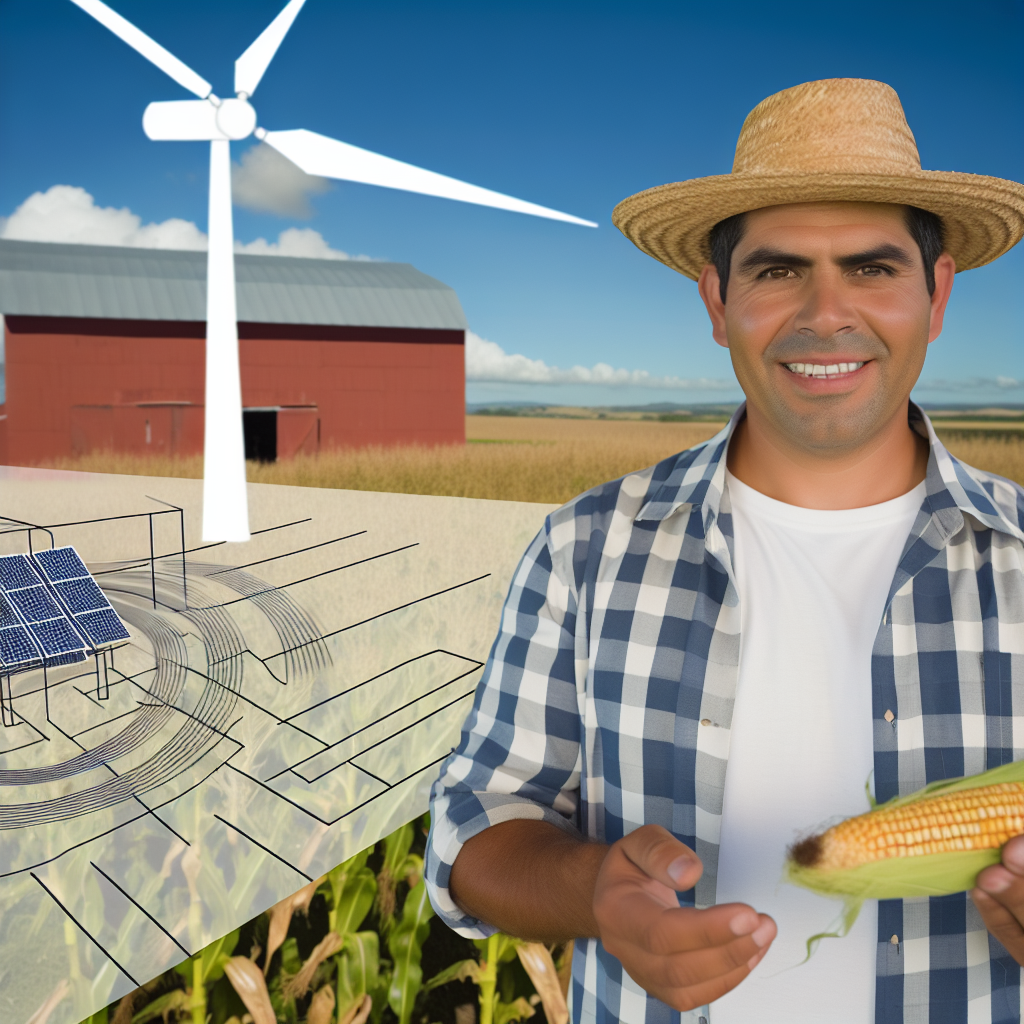Introduction to Renewable Energy in Agriculture
Renewable energy plays a crucial role in modern agriculture.
It helps reduce greenhouse gas emissions significantly.
Farmers are increasingly adopting renewable technologies.
This trend promotes sustainability and energy independence.
Understanding Renewable Energy Sources
Solar energy is one of the most popular sources.
Farmers install solar panels to power their operations.
Wind energy is another viable option.
Wind turbines can generate significant electricity on farms.
Additionally, bioenergy harnesses waste products from farming.
The Importance of Incentives
Government incentives encourage farmers to go green.
These incentives can take the form of grants or tax credits.
Financial assistance reduces the initial investment costs.
Moreover, incentives often promote research into new technologies.
Challenges Facing Adoption
Despite the benefits, challenges remain.
The initial cost of renewable energy systems can be high.
Transform Your Agribusiness
Unlock your farm's potential with expert advice tailored to your needs. Get actionable steps that drive real results.
Get StartedIn addition, some farmers lack knowledge about these technologies.
Access to reliable information is vital for successful implementation.
The Future of Renewable Energy in Agriculture
The future looks bright for renewable energy in farming.
As technology advances, costs will continue to decline.
Farmers will increasingly adopt these innovations globally.
This transition will improve agricultural productivity significantly.
Ultimately, renewable energy will lead to a more sustainable future.
Overview of Renewable Energy Incentives
Types of Renewable Energy Incentives
Renewable energy incentives can vary widely in nature.
They typically include tax credits, grants, and rebates.
Tax credits significantly reduce the amount of tax owed by farmers.
Grants provide upfront funding for renewable energy projects.
Rebates offer partial refunds for investments in renewable technologies.
Additionally, some programs provide low-interest loans for energy systems.
Benefits of Renewable Energy Incentives
These incentives encourage farmers to adopt sustainable practices.
They lower the overall costs of renewable energy installations.
Furthermore, they help protect against fluctuating energy prices.
Consequently, farmers can achieve energy independence.
Additionally, using renewable energy often improves farm profitability.
Moreover, these initiatives contribute to environmental sustainability.
They help reduce greenhouse gas emissions and reliance on fossil fuels.
Thus, renewable energy incentives represent a win-win for farmers and the environment.
Federal Incentives for Renewable Energy in Agriculture
Overview of Federal Programs
The federal government offers various incentives for renewable energy.
These programs aim to support sustainable agricultural practices.
For instance, the USDA provides funding for renewable energy projects.
Showcase Your Farming Business
Publish your professional farming services profile on our blog for a one-time fee of $200 and reach a dedicated audience of farmers and agribusiness owners.
Publish Your ProfileMoreover, specific tax credits encourage farmers to adopt clean technologies.
Tax Credits and Deductions
Farmers can benefit from several tax credits related to renewable energy investments.
The Investment Tax Credit (ITC) allows a percentage of the cost to be deducted from tax liabilities.
This tax credit applies to solar, wind, and other renewable energy projects.
Additionally, the Production Tax Credit (PTC) reduces tax obligations based on energy produced.
Specific USDA Programs
The USDA runs the Rural Energy for America Program (REAP).
REAP offers grants and loans for renewable energy systems and energy efficiency improvements.
Farmers can receive up to 25% in grant funding for project costs.
Furthermore, the program encourages the use of biomass energy systems.
State-Level Support
Many states provide additional incentives for renewable energy adoption.
These programs often complement federal efforts.
For example, some states offer rebates for solar panel installation.
States may also provide low-interest loans for energy efficiency upgrades.
Accessing Funding Opportunities
Farmers should explore various avenues for accessing federal funding.
The USDA website serves as a valuable resource for information on available programs.
Additionally, local extension offices can offer guidance on navigating these incentives.
Networking with fellow farmers can also provide insights into successful funding strategies.
Learn More: Future of Farming Under Climate Change Legislation
State-Specific Incentives: A Comparative Analysis
Introduction to State Incentives
Renewable energy incentives vary across states.
Understanding these differences can optimize agricultural investment.
Each state provides unique programs and benefits.
California Energy Programs
California leads in renewable energy initiatives for agriculture.
The state offers substantial tax credits for solar installations.
Farmers can also access low-interest loans for energy projects.
Additionally, the California Energy Commission provides grants.
Texas Renewable Energy Initiatives
Texas encourages wind energy adoption among farmers.
The state provides property tax exemptions for renewable projects.
Moreover, incentives for large-scale wind farms support community growth.
Farmers are urged to explore partnerships with energy developers.
New York Solar Energy Programs
New York has robust solar incentive programs for agriculture.
Farmers can benefit from performance-based incentives.
The state also offers direct rebates for solar PV installations.
Participation in state initiatives enhances farm resilience.
Florida Renewable Energy Tax Credits
Florida promotes solar energy through various tax credits.
Agricultural producers can receive exemptions on solar equipment.
This boosts on-farm energy independence and sustainability.
Furthermore, the state encourages community solar projects.
Comparison of Incentives Across States
Each state’s incentives feature distinct strengths and features.
California excels in funding availability and diverse programs.
Texas shines in wind energy incentives and property tax benefits.
Showcase Your Farming Business
Publish your professional farming services profile on our blog for a one-time fee of $200 and reach a dedicated audience of farmers and agribusiness owners.
Publish Your ProfileNew York’s focus on solar energy assists farmers in reducing costs.
Florida’s tax credits foster accessibility to renewable technologies.
Challenges and Considerations
Despite the benefits, challenges remain for farmers.
Navigating complex incentives requires time and resources.
Some farmers may encounter funding limitations or requirements.
Therefore, understanding local regulations is crucial for success.
See Related Content: How Agricultural Insurance Protects Against Natural Disasters
Case Studies: Successful Implementation of Renewable Energy in Farming
Solar Energy in Vineyards
Sunny Hill Vineyards in California adopted solar panels in 2018.
This transition cut energy costs by 30% for the vineyard.
Moreover, they sell excess energy back to the grid.
This practice created an additional revenue stream.
Furthermore, the farm promotes environmental sustainability.
Wind Energy on Dairy Farms
The Green Pastures Dairy Farm in Wisconsin installed wind turbines last year.
These turbines generate about 50% of the farm’s energy needs.
As a result, the farm reduced its carbon footprint significantly.
Additionally, neighbors enjoyed a cleaner local environment.
Wind energy contributed to lower electricity bills and reliable power.
Biodiesel from Crops
Hilltop Farms in Texas produced biodiesel from their soybean harvests.
This initiative started in 2019 and enhanced their sustainability efforts.
Biodiesel reduced transportation costs for delivering products.
Moreover, it decreased dependence on fossil fuels.
Consequently, the farm gained recognition for innovation in energy use.
Geothermal Energy for Greenhouses
Evergreen Greenhouses in Oregon implemented geothermal heating systems.
This system maintains temperature without heavy reliance on fossil fuels.
Since the installation, energy costs decreased by 25%.
Additionally, plants thrive under constant, controlled conditions.
As a result, Evergreen Greenhouses enjoy extended growing seasons.
Hydroponics and Rainwater Harvesting
Clearwater Farms in Florida utilizes hydroponic systems for crops.
They also harvest rainwater to meet irrigation needs.
This combination promotes water conservation and efficiency.
Additionally, it reduces reliance on external water sources.
Consequently, the farm produces high yields while minimizing impacts.
See Related Content: Maximizing Renewable Energy Incentives for Modern Farms

Challenges Faced by Farmers in Accessing Renewable Energy Incentives
Complexity of Incentive Programs
Farmers often find renewable energy incentive programs complex.
This complexity makes it difficult for them to understand available benefits.
Regulatory jargon can create barriers to entry for many farmers.
Moreover, detailed applications frequently overwhelm those unaccustomed to paperwork.
Lack of Awareness and Education
Many farmers remain unaware of the renewable energy programs available to them.
This lack of awareness limits their participation in potentially beneficial initiatives.
Additionally, educational resources on these programs are often insufficient.
Showcase Your Farming Business
Publish your professional farming services profile on our blog for a one-time fee of $200 and reach a dedicated audience of farmers and agribusiness owners.
Publish Your ProfileFarmers might not know where to find reliable information.
Financial Barriers
Upfront costs for renewable energy technologies can deter farmers.
Investments in solar panels or wind turbines often exceed initial budgets.
As a result, securing necessary funding becomes a major hurdle.
Farmers seeking loans may face challenges with lending criteria.
Geographical Limitations
Some regions lack access to renewable energy resources entirely.
This geographic disparity impacts farmers’ ability to harness renewables.
Remote areas often face logistical challenges in implementing new technologies.
Consequently, farmers in these regions may feel neglected by incentive programs.
Variation in State Programs
Incentives can vary widely from state to state.
This inconsistency complicates the decision-making process for farmers.
Some states offer generous benefits, while others provide minimal support.
Farmers might struggle to navigate these differing landscapes.
Technological Challenges
Adopting new technologies can be intimidating for many farmers.
They may lack the technical expertise required for installation and maintenance.
Moreover, some farmers fear that integrating renewable energy will disrupt operations.
Training programs are often necessary but not widely available.
Find Out More: Understanding Government Conservation Incentives For Farmers
Future Trends in Renewable Energy Incentives for Agriculture
Increasing Government Support
Government policies will increasingly favor renewable energy initiatives in agriculture.
These policies will aim to reduce dependency on fossil fuels.
Furthermore, subsidies for solar and wind energy will likely expand.
Farmers can expect more financial incentives for adopting these technologies.
This support will help in offsetting initial investment costs.
Emergence of Innovative Financing Models
Innovative financing models will emerge in the agricultural sector.
These models will facilitate greater access to capital for renewable energy projects.
Participatory financing options will involve community investments.
Moreover, partnerships with private investors will strengthen funding opportunities.
These approaches will nurture a collaborative environment for growth.
Adoption of Advanced Technologies
Advanced technologies will drive the renewable energy transition in farming.
For instance, smart grid technology will enhance energy management.
Also, energy storage solutions will become more accessible to farmers.
These innovations will optimize energy usage and reduce waste.
Consequently, farmers will benefit from improved efficiency.
Focus on Sustainability and Resilience
Sustainability will be a key focus for agriculture in the coming years.
Renewable energy will enhance the sector’s resilience against climate change.
Moreover, practices will promote responsible resource management.
Farmers will be encouraged to adopt sustainable agricultural practices.
This shift will ensure ecological balance and long-term viability.
Collaboration Across the Industry
Collaboration among stakeholders will become increasingly important.
Farmers, energy providers, and policymakers will need to work together.
Showcase Your Farming Business
Publish your professional farming services profile on our blog for a one-time fee of $200 and reach a dedicated audience of farmers and agribusiness owners.
Publish Your ProfileThis synergy will facilitate the sharing of knowledge and resources.
Consequently, innovative solutions will emerge to address common challenges.
Such collaborations will also drive policy reform for better incentives.
The Role of Renewable Energy in Sustainable Agriculture
Introduction to Renewable Energy in Agriculture
Renewable energy plays a vital role in modern agriculture.
It reduces dependence on fossil fuels and lowers greenhouse gas emissions.
Additionally, farmers utilize various renewable sources, including solar and wind.
Benefits of Renewable Energy
Using renewable energy sources provides several economic benefits.
Lower energy costs improve the profitability of farms.
Furthermore, it allows farmers to reinvest savings into their operations.
In addition, harnessing renewables enhances energy independence.
Adopting Renewable Technologies
Farmers can adopt multiple technologies to harness renewable energy.
Solar panels are among the most popular options available.
Wind turbines also offer a powerful alternative for many operations.
Moreover, biogas from livestock waste presents a viable energy source.
Incentives for Farmers
Governments provide various incentives to encourage renewable energy use.
Tax credits significantly reduce the initial costs of installation.
Grants also assist farmers in funding renewable energy projects.
Moreover, many regions offer low-interest loans for farmers seeking upgrades.
The Future of Farming with Renewable Energy
Renewable energy usage in agriculture will likely continue growing.
As technology advances, efficiency will improve and costs will decrease.
Consequently, more farmers will adopt these solutions.
This transition leads to increased sustainability in food production systems.
Additional Resources
Alternative Fuels Data Center: Biodiesel Laws and Incentives in …
Agriculture and Food Research Initiative – Sustainable Agricultural …




